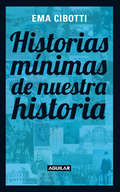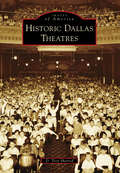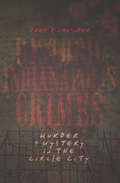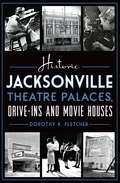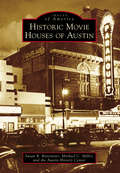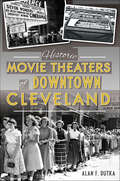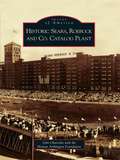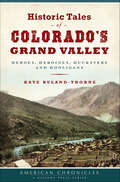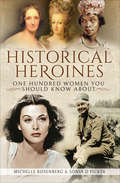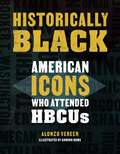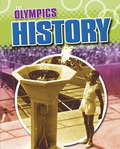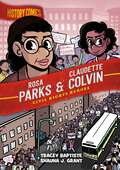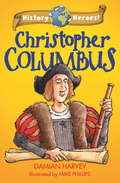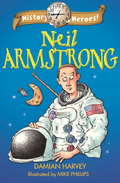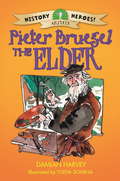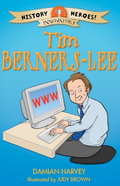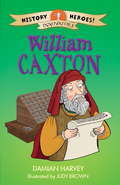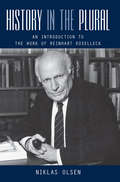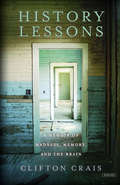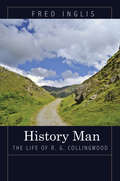- Table View
- List View
Historias mínimas de nuestra historia
by Ema CibottiLa historiadora Ema Cibotti rescata del olvido pequeñas historias que revelan una espesa trama de hechos menudos, muchas veces obviados que sin embargo son constitutivos de nuestro pasado. Nuestra nación puede compararse con un edificio en perpetua construcción. A lo largo de la historia se han ido levantando los cimientos, las columnas y las vigas, y su fachada suele variar de color según quién se haga cargo del relato. Pero para descubrir los ladrillos y el cemento que le dan significado y lo hacen habitable, esos relatos no son suficientes: es necesario acercarse, palpar los ladrillos y hurgar debajo de las muchas capas de pintura que los cubren. La historiadora Ema Cibotti agregó a sus conocimientos la búsqueda en cartas y memorias, en documentos oficiales y particulares, y con eso urdió estas pequeñas historias que revelan una espesa trama de hechos menudos, muchas veces obviados o directamente a punto de perderse en el olvido, que sin embargo son constitutivos de nuestro pasado, como lo son de ese edificio los ladrillos y el cemento. Los redactores de la Constitución en una tórrida aldea llamada Santa Fe; la declaración de amor de Carmen, la esposa del cacique Railef; más de sesenta ediciones de Anagnosia, el libro para aprender a leer que se vendía en el almacén; la verdadera revolución que avanzaba detrás de una zanja casi interminable; 459 diarios sostenidos por el ansia de información; tres seudónimos para una original operación literaria; la excluida población negra; mujeres maestras, mujeres periodistas, mujeres poetas, mujeres bandoneonistas; los protagonistas de un cuadro trágico; puchero, pizza y milanesas; un dandy en las filas de la democracia, son algunas de las historias que componen esta obra y que consolidan el edificio que seguimos construyendo. La crítica ha dicho... «La historiadora Ema Cibotti, sin demagogias discursivas ni afán de derribar próceres para ganarse a los detractores del sistema escolar, renueva la visión de la historia alumbrando rincones deliciosos y polémicos del escenario nacional.» Silvia Hopenhayn, La Nación
Historic Dallas Theatres
by D. Troy SherrodDallas was the show business capital of Texas and much of the South throughout the 20th century. More than 100 theatres served the city's neighborhoods, and Elm Street once boasted more than 15 vaudeville and movie theatres--second in number to Broadway. The quality of the show houses in Dallas were surpassed by few cities and all major, and most minor, Hollywood studios maintained Dallas offices. Notable names figuring in this history include Margo Jones, "Blind" Lemon Jefferson, Karl Hoblitzelle, Baruch Lumet, Bob Hope, Greer Garson, Linda Darnell, Howard Hughes, Clyde Barrow, Gene Autry, Oliver Stone, Pappy Dolson, Jack Ruby, Lee Harvey Oswald, Nicola Rescigno, Don Henley, and Frank Lloyd Wright.
Historic Indianapolis Crimes: Murder & Mystery in the Circle City (Murder And Mayhem Ser.)
by Fred D. CavinderFrom the 1954 &“Dresser Drawer Murder&” to the mass killing of seven people in 2006, the author of Forgotten Hoosiers chronicles Indianapolis&’s dark history. Hear tales from the Circle City&’s murderous underbelly, from poor Silvia Likens, who was tortured for months by her foster mother and eventually discovered dead, to Carrie Selvage, whose skeleton was found in an attic twenty years after she disappeared from a hospital bed in 1900. Discover how housekeepers found Dorothy Poore stuffed in a dresser drawer on a July day in 1954 and the curious story of Marjorie Jackson, her body was discovered clothed in pajama bottoms and a flannel robe on her kitchen floor, and police found $5 million hidden around her house in garbage cans, drawers, closets, toolboxes and a vacuum cleaner bag. Join local historian Fred Cavinder as he recounts the gruesome tales of Indiana&’s capital city, from mystery to murder. Includes photos!
Historic Jacksonville Theatre Palaces, Drive-ins and Movie Houses (Landmarks)
by Dorothy K. FletcherJacksonville's theatre and performance history is rich with flair and drama. The theatres, drive-ins and movie houses that brought entertainment to its citizens have their own exciting stories. Some have passed into memory. The Dixie Theatre, originally part of Dixieland Park, began to fade in 1909. The Palace Theatre, home to vaudeville acts, was torn down in the '50s. The Alhambra has been everyone's favorite dinner theatre since 1967's debut of Come Blow Your Horn. Local author Dorothy K. Fletcher revives the history of Jacksonville's theatres. Lights, camera, action!
Historic Movie Houses of Austin (Images of America)
by Austin History Center Michael C. Miller Susan RittereiserMotion pictures came to Austin on October 10, 1896, debuting at the Hancock Opera House. Since then, movies have continued to enchant, entertain, and inform the citizens of the capital of Texas. And, the places--the movie houses and theaters--where people saw motion pictures played just as important a role in the moviegoing experience as the movies themselves. As the city's population grew and motion picture technology changed, so too did Austin's movie houses, from the first kinetoscope parlor on Congress Avenue to the city' s first four-plex, the Aquarius 4, in southeast Austin. While most of these places are long gone, some withstood the test of time and are still showing movies or have been repurposed for other uses. Through the rich archival collections of the Austin History Center, Historic Movie Houses of Austin explores the stories of these important historic spaces and of the lives of those who were connected with them.
Historic Movie Theaters of Downtown Cleveland (Landmarks)
by Alan F. DutkaThe first movie theaters in Cleveland consisted of converted storefronts with sawed-off telephone poles substituting for chairs and bedsheets acting as screens. In 1905, Clevelanders marveled at moving images at Rafferty's Monkey House while dodging real monkeys and raccoons that wandered freely through the bar. By the early 1920s, a collection of marvelous movie palaces like the Stillman Theater lined Euclid Avenue, but they survived for just two generations. Clevelanders united to save the State, Ohio and Allen Theaters, among others, as wrecking balls converged for demolition. Those that remain compose one of the nation's largest performing arts centers. Alan F. Dutka shares the remarkable histories of Cleveland's downtown movie theaters and their reemergence as community landmarks.
Historic Sears, Roebuck and Co. Catalog Plant
by John Oharenko Homan Arthington FoundationLocated on the site of the original Sears Tower, the historic Sears, Roebuck and Company catalog plant is one of the nation's most unique landmarks. Representing American ingenuity at its best, Richard Sears and Julius Rosenwald combined technology, commerce, and social science with bricks and mortar to build "the World's Largest Store" on Chicago's West Side. Completed in 1906, the plant housed nearly every conceivable product of the time: clothing, jewelry, furniture, appliances, tools, and more. The complex employed 20,000 people, and merchandise orders were processed and delivered by rail--within the same day. During the first two decades of the 20th century, almost half of America's families shopped the over 300 million catalogs published in that era. WLS (World's Largest Store) Radio broadcasted the Gene Autrey show from the top of the tower, and the first Sears retail store opened here on Homan Avenue and Arthington Street. In 1974, Sears moved to the current Sears Tower. Thanks to many individuals who fought to save these architecturally and historically important treasures, the administration building, the original Sears Tower, the catalog press-laboratory building, and the powerhouse remain today. There are currently plans for redeveloping these buildings into housing, office, and retail space. A new Homan Square Community Center stands on the site of the merchandise building.
Historic Tales of Colorado’s Grand Valley: Heroes, Heroines, Hucksters and Hooligans (American Chronicles)
by Kate Ruland-ThorneColorado's Grand Valley has an extensive geological and human history going back millennia. Franciscan priests worked in tandem with the native Ute people to plot passage through the territory, opening the valley to unprecedented settlement. The region became the playground of enterprising visionaries, murderous outlaws, hooligans and harlots alike. From the gruesome Meeker massacre and its tragic consequences for the Ute nation to the mysterious murder of Sam McMullin and a showdown with the Ku Klux Klan in 1925, uncover the engrossing stories of an unyielding land. Author Kate Ruland-Thorne recounts many of the defining and damning moments throughout Grand Valley history.
Historic Theaters of New York's Capital District (Landmarks)
by John A. MillerExperience the architecture and colorful history of the Historic Theaters of New York's Capital District as author John A. Miller charts the entertaining history.For generations, residents of New York's Capital District have flocked to the region's numerous theaters. The history behind the venues is often more compelling than the shows presented in them.John Wilkes Booth brushed with death on stage while he and Abraham Lincoln were visiting Albany. The first exhibition of broadcast television was shown at Proctor's Theater in Schenectady, although the invention ironically contributed to the downfall of theaters across the nation. A fired manager of the Green Street Theatre seized control of the theater with a group of armed men, but Albany police stormed the building and the former manager regained control.
Historical Heroines: One Hundred Women You Should Know About
by Michelle Rosenberg Sonia D PickerFrom Mata Hari and Pocahontas to Lucrezia Borgia and Hedy Lamarr—fascinating portraits of history’s most unforgettable, and some unjustly forgotten, women. Cleopatra. Audrey Hepburn. Sappho. Calamity Jane. Marie Antoinette. Lilith. Harriet Beecher Stowe. Dame Emma Hamilton. Mary Shelley. Mary Frith. Some are celebrated in folklore legend; some are remembered only as movie stars; many will be familiar in their native countries; while others are, for the most part, unjustly unknown. Not anymore. Let this rewarding anthology set the record straight on: World War I heroine and nurse Edith Cavell; turn of the century Iñupiat explorer Ada Blackjack; eighteenth-century abolitionist, slave, and women’s rights pioneer Soujourner Truth; Gorgo, 480 BC Queen of Sparta; Agent 355, the American Revolution’s most mysterious spy; nineteenth-century socialite and archaeologist Lady Hester Stanhope; eighteenth-century Irish physician Margaret Bulky who plied her trade by passing as a man for fifty years; and many, many more adventurers, leaders, and freedom fighters—each and every one, a groundbreaker whose name deserves a place in history.
Historically Black: American Icons Who Attended HBCUs
by Alonzo VereenA vibrant collection of biographies and illustrated portraits that capture the brilliance of more than thirty American icons, Historically Black is a celebration of Black excellence in fields ranging from politics to STEM, sports to pop culture, and more.From the moment the first HBCU was founded in 1837, Black Americans from all walks of life have created collegiate experiences that enrich and transcend mainstream postsecondary education. Today, more than 100 colleges and universities are registered under the HBCU banner and over 200,000 students are enrolled. With a legacy of marching bands, drill teams, choral ensembles, homecoming, and more, attending an HBCU is an emblem of pride and a source of joy. Historically Black documents not only HBCU cultural traditions but also the remarkable stories of former students. HBCU attendees in the book include: Booker T. Washington, James Weldon Johnson, Ida B. Wells-Barnett, W.E.B. Du Bois, Mary McLeod Bethune, Alice Dunbar Nelson, Zora Neale Hurston, Howard Thurman, Langston Hughes, Thurgood Marshall, Bayard Rustin, Dorothy Vaughan, Katherine Johnson, Mary Jackson, Leontyne Price, Martin Luther King, Jr., Toni Morrison, John Lewis, Bob Hayes, Oprah Winfrey, Kamala Harris, Hakeem M. Oluseyi, Taraji P. Henson, Erykah Badu, Stacey Abrams, Ta-Nehisi Coates, Chadwick Boseman, Hebru Brantley, Ibram X. Kendi, J.R. Smith, Megan Thee Stallion, and Mo&’ne Davis.
History
by Moira ButterfieldEach title of The Olympics examines the the Olympic Games from ancient times, then the revival of the 1890s through to today's multi-million pound business. From the history of the games to which events are included and why, and from scandals to record breakers, The Olympics puts the reader at the centre of the action with fact-packed text, dramatic full-colour photos, facts and statistics.
History (The Olympics #3)
by Moira ButterfieldEach title of The Olympics examines the the Olympic Games from ancient times, then the revival of the 1890s through to today's multi-million pound business. From the history of the games to which events are included and why, and from scandals to record breakers, The Olympics puts the reader at the centre of the action with fact-packed text, dramatic full-colour photos, facts and statistics.
History Comics: Civil Rights Heroes (History Comics)
by Tracey BaptisteTurn back the clock with History Comics! In this volume, learn about two brave women who stood up against segregation, setting in motion the Montgomery Bus Boycott!A Black woman who refused to give up her seat on a segregated bus sparked a bus boycott and became part of one of the most iconic moments in American history. Yet, few know that Rosa Parks had actively worked toward social justice her whole life. And even fewer know that the seeds of the statewide bus boycott were first planted by a teenager named Claudette Colvin, who was arrested on similar charges months earlier. Rosa Parks and Claudette Colvin inspired a nation, showing how positive change can start with a single defiant act. Their actions have become the stuff of legend, but there is so much more to their lives, their stories, and the movement they began.
History Heroes: Christopher Columbus
by Damian HarveyChristopher Columbus sailed the seas in search of the perfect trade route - find out how his life and explorations helped to change the world! Discover the stories of people who have helped to shape history, ranging from early explorers such as Christopher Columbus to more modern figures like Tim Berners-Lee, inventor of the World Wide Web. These chapter books combine historical fact with engaging narrative and humourous illustration, perfect for the newly independent reader.
History Heroes: Neil Armstrong
by Damian HarveyNeil Armstrong was involved in one of the most memorable events of the twentieth century - the moon landing! Find out more about how he got to become one of the first to set foot on the moon. Discover the stories of people who have helped to shape history, ranging from early explorers such as Christopher Columbus to more modern figures like Tim Berners-Lee, inventor of the World Wide Web. These chapter books combine historical fact with engaging narrative and humourous illustration, perfect for the newly independent reader.
History Heroes: Pieter Bruegel the Elder
by Damian Harvey Yulyia SominaPieter Bruegel, the greatest Flemmish painter of the 16th Century, developed a unique style of painting and created many masterpieces, often painting scenes of daily life. Discover the stories of people who have helped to shape history, ranging from early explorers such as Christopher Columbus to more modern figures like Tim Berners-Lee, inventor of the World Wide Web. These chapter books combine historical fact with engaging narrative and humourous illustration, perfect for the newly independent reader.
History Heroes: Tim Berners-Lee
by Damian Harvey Judy BrownTim Berners Lee started off his career building computers out of old televisions. He is now one of the most prolific internet experts in the world and was responsible for founding the World Wide Web! Discover the stories of people who have helped to shape history, ranging from early explorers such as Christopher Columbus to more modern figures like Tim Berners-Lee, inventor of the World Wide Web. These chapter books combine historical fact with engaging narrative and humourous illustration, perfect for the newly independent reader.
History Heroes: William Caxton
by Damian Harvey Judy BrownWilliam Caxton led the way in bringing the printing press to the English and made books accessible to many people. Discover the stories of people who have helped to shape history, ranging from early explorers such as Christopher Columbus to more modern figures like Tim Berners-Lee, inventor of the World Wide Web. These chapter books combine historical fact with engaging narrative and humourous illustration, perfect for the newly independent reader.
History In The Plural
by Niklas OlsenReinhart Koselleck (1923-2006) was one of most imposing and influential European intellectual historians in the twentieth century. Constantly probing and transgressing the boundaries of mainstream historical writing, he created numerous highly innovative approaches, absorbing influences from other academic disciplines as represented in the work of philosophers and political thinkers like Hans Georg Gadamer and Carl Schmitt and that of internationally renowned scholars such as Hayden White, Michel Foucault, and Quentin Skinner. An advocate of "grand theory," Koselleck was an inspiration to many scholars and helped move the discipline into new directions (such as conceptual history, theories of historical times and memory) and across disciplinary and national boundaries. He thus achieved a degree of international fame that was unusual for a German historian after 1945. This book not only presents the life and work of a "great thinker" and European intellectual, it also contributes to our understanding of complex theoretical and methodological issues in the cultural sciences and to our knowledge of the history of political, historical, and cultural thought in Germany from the 1950s to the present.
History Lessons
by Clifton CraisBorn in Louisiana to a soon-to-be absent father and an alcoholic mother--who tried to drown him in a bathtub when he was three--Clifton Crais spent his childhood perched beside his mother on a too-tall bar stool, living with relatives too old or infirmed to care for him, or rambling on his own through New Orleans, a city both haunted and created by memory. Indeed, it is memory--both elusive and essential--that forms the center of Crais's beautifully rendered memoir History Lessons. In an effort to restore his own, Crais brings the tools of his formal training as a historian to bear on himself and his family. He interviews his sisters and his mother, revisits childhood homes and pores over documentary evidence: plane tickets, postmarks, court and medical records, crumbling photo albums. Probing family lore, pushing past silences and exhuming long-buried family secrets, he arrives, ultimately, at the deepest reaches of the brain. Crais examines the science of memory and forgetting, from the ways in which experience shapes the developing brain to the mechanisms that cause the chronic childhood amnesia--the most common and least understood form of amnesia--from which he suffers. Part memoir, part narrative science and part historical detective story, History Lessons is a provocative, exquisitely crafted investigation into what it means to be human.
History Lessons: A Memoir of Madness, Memory, and the Brain
by Clifton CraisBorn in Louisiana to a soon-to-be absent father and an alcoholic mother--who tried to drown him in a bathtub when he was three--Clifton Crais spent his childhood perched beside his mother on a too-tall bar stool, living with relatives too old or infirmed to care for him, or rambling on his own through New Orleans, a city both haunted and created by memory. Indeed, it is memory--both elusive and essential--that forms the center of Crais's beautifully rendered memoir History Lessons. In an effort to restore his own, Crais brings the tools of his formal training as a historian to bear on himself and his family. He interviews his sisters and his mother, revisits childhood homes and pores over documentary evidence: plane tickets, postmarks, court and medical records, crumbling photo albums. Probing family lore, pushing past silences and exhuming long-buried family secrets, he arrives, ultimately, at the deepest reaches of the brain. Crais examines the science of memory and forgetting, from the ways in which experience shapes the developing brain to the mechanisms that cause the chronic childhood amnesia--the most common and least understood form of amnesia--from which he suffers. Part memoir, part narrative science and part historical detective story, History Lessons is a provocative, exquisitely crafted investigation into what it means to be human.
History Lessons: A Memoir of Madness, Memory, and the Brain
by Clifton CraisBorn in Louisiana to a soon-to-be absent father and an alcoholic mother—who tried to drown him in a bathtub when he was three—Clifton Crais spent his childhood perched beside his mother on a too-tall bar stool, living with relatives too old or infirmed to care for him, or rambling on his own through New Orleans, a city both haunted and created by memory. Indeed, it is memory—both elusive and essential—that forms the center of Crais’s beautifully rendered memoir History Lessons. In an effort to restore his own, Crais brings the tools of his formal training as a historian to bear on himself and his family. He interviews his sisters and his mother, revisits childhood homes and pores over documentary evidence: plane tickets, postmarks, court and medical records, crumbling photo albums. Probing family lore, pushing past silences and exhuming long-buried family secrets, he arrives, ultimately, at the deepest reaches of the brain. Crais examines the science of memory and forgetting, from the ways in which experience shapes the developing brain to the mechanisms that cause the chronic childhood amnesia—the most common and least understood form of amnesia—from which he suffers. Part memoir, part narrative science and part historical detective story, History Lessons is a provocative, exquisitely crafted investigation into what it means to be human.
History Man: The Life of R. G. Collingwood
by Fred InglisThis is the first biography of the last and greatest British idealist philosopher, R. G. Collingwood (1889-1943), a man who both thought and lived at full pitch. Best known today for his philosophies of history and art, Collingwood was also a historian, archaeologist, sailor, artist, and musician. A figure of enormous energy and ambition, he took as his subject nothing less than the whole of human endeavor, and he lived in the same way, seeking to experience the complete range of human passion. In this vivid and swiftly paced narrative, Fred Inglis tells the dramatic story of a remarkable life, from Collingwood's happy Lakeland childhood to his successes at Oxford, his archaeological digs as a renowned authority on Roman Britain, his solo sailing adventures in the English Channel, his long struggle with illness, and his sometimes turbulent romantic life. In a manner unheard of today, Collingwood attempted to gather all aspects of human thought into a single theory of practical experience, and he wrote sweeping accounts of history, art, science, politics, metaphysics, and archaeology, as well as a highly regarded autobiography. Above all, he dedicated his life to arguing that history--not science--is the only source of moral and political wisdom and self-knowledge. Linking the intellectual and personal sides of Collingwood's life, and providing a rich history of his milieu, History Man also assesses Collingwood's influence on generations of scholars after his death and the renewed recognition of his importance and interest today.
